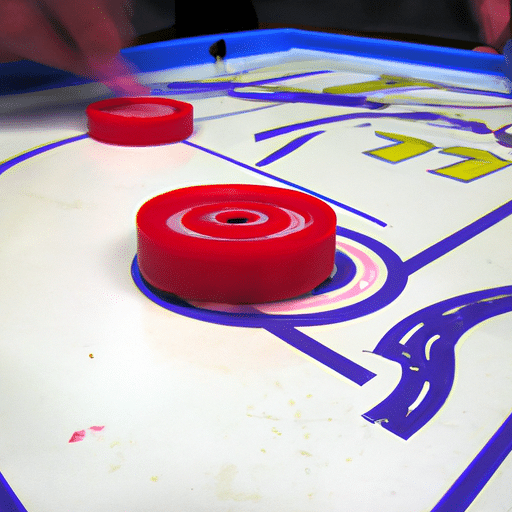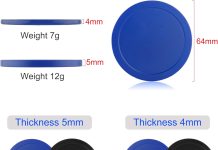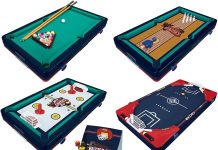Air hockey is an exhilarating and fast-paced game that has gained popularity worldwide. In this article, we will explore the fundamental rules of air hockey, allowing you to brush up on your knowledge or learn something new if you’re a novice player. From understanding the objective of the game to mastering the various techniques, we aim to equip you with the essential rules that will enhance your enjoyment of this thrilling sport. So, let’s dive into the world of air hockey and discover the rules that govern this exciting game!
Review contents
Objective of the Game
In air hockey, the objective of the game is simple – to score more points than your opponent. The game is played on an air hockey table, with two players competing against each other. It’s a fast-paced and exciting game that requires quick reflexes and precise movements.
Scoring Points
To score points in air hockey, players must hit the puck into their opponent’s goal. Each time the puck crosses the goal line and enters the opponent’s goal, a point is awarded. The player with the most points at the end of the game wins.
Winning the Game
To win the game, players must reach a predetermined number of points, often 7 or 9. The first player to reach this number of points wins the game. In the event of a tie, the game can go into overtime, where the first player to score a point wins.
Equipment
Air Hockey Table
The air hockey table is the centerpiece of the game. It is a large, smooth surface with tiny holes that blow air through to create a cushion of air. This allows the puck to glide easily across the table. The table usually comes with a scoring system and timers to keep track of the game.
Pucks
Pucks are the playing pieces used in air hockey. They are flat, round discs made of plastic and are usually lightweight. The pucks have smooth edges and a concave shape to allow the air to flow underneath, making it easier for them to glide across the table.
Mallets
Mallets, also known as paddles, are used by the players to strike the puck. They are typically made of plastic and have a flat bottom surface. The mallets are held by the players and are used to hit the puck back and forth across the table.
Positioning and Gameplay
Player Positions
In air hockey, players stand on opposite sides of the table. Each player is positioned at their end, with their goal behind them and the opponent’s goal in front. This allows for a fair and balanced gameplay, as both players have equal access to the puck.
Starting the Game
To start the game, both players place their mallets on the centerline of the table. The puck is then released onto the table, and the players have to battle it out to gain control. The game begins once the puck is in play.
Serving
In air hockey, the serve is an important aspect of the game. The player who scored the last point is responsible for serving the puck. The serve can be performed by hitting the puck from the player’s side of the table and passing it through the centerline.
Taking Turns
Once the game is in play, both players take turns hitting the puck. The objective is to score points by getting the puck past the opponent’s mallet and into their goal. Each player has the opportunity to strike the puck when it is on their side of the table.
Illegal Shots
Certain shots in air hockey are considered illegal and are not allowed. These include using a mallet to scoop or lift the puck off the table, blocking the opponent’s mallet with hands or body, and intentionally knocking the opponent’s mallet away. These illegal shots can result in penalties or the loss of a point.
Scoring
Scoring a Point
To score a point in air hockey, players must successfully hit the puck into their opponent’s goal. The puck must cross the goal line and fully enter the goal to count as a point. If the puck bounces off the edge of the goal or does not fully enter, it does not count as a point.
Scoring System
The scoring system in air hockey is straightforward. Each time a player successfully scores a point, one point is added to their overall score. The player with the highest score at the end of the game is declared the winner.
Fouls and Penalties
Illegal Moves
In air hockey, there are certain moves that are considered illegal and are penalized. These illegal moves include touching the puck with anything other than the mallet, intentionally hitting the puck out of play, and interfering with the opponent’s shot by blocking or obstructing their view. Players who commit these illegal moves may receive penalties or lose a point.
Touching the Puck
Players must only use their mallets to touch the puck during gameplay. Touching the puck with any other part of the body or any other object is not allowed. This rule ensures fair and consistent gameplay for both players.
Slamming
Slamming is a move where a player hits the puck excessively hard in an attempt to overpower their opponent. Slamming is not allowed in air hockey as it can be dangerous and may damage the table or equipment. Players who engage in slamming may face penalties or be disqualified from the game.
Time Limit
Game Duration
Air hockey games typically have a time limit, usually ranging from 5 to 10 minutes. This ensures that games progress at a reasonable pace and allows for fair gameplay. Once the time limit is reached, the player with the highest score wins the game.
Overtime
In the event of a tie at the end of the time limit, the game can go into overtime. Overtime is an additional period of gameplay where players continue to compete until one player scores a point. The first player to score in overtime is declared the winner of the game.
Strategy and Tips
Defense
Defense is a crucial aspect of air hockey. Players need to focus on protecting their goal and preventing the opponent from scoring points. This can be achieved by positioning the mallet strategically, anticipating the opponent’s moves, and practicing quick reflexes.
Offense
While defense is important, offense is equally crucial in air hockey. Players should aim to score points by hitting the puck past their opponent’s mallet and into the goal. This can be achieved by practicing accurate shots, utilizing angles, and capitalizing on rebounds.
Angling
Angling is a technique that involves hitting the puck at an angle to redirect its trajectory. By angling the mallet correctly, players can create shots that are difficult for the opponent to defend against. Angling requires practice and precision to master.
Rebounds
Rebounds are a common occurrence in air hockey. By hitting the puck off the edges of the table at specific angles, players can create opportunities for rebounds. Rebounds can catch the opponent off guard and lead to scoring points. Mastering the art of rebounds can greatly enhance a player’s gameplay.
Famous Air Hockey Champions
Top Players
Over the years, several players have emerged as top competitors in the world of air hockey. These players have showcased exceptional skills, quick reflexes, and strategic gameplay. Some notable names include Danny Hynes, Billy Stubbs, and Tim Weissman. These players have set the bar high and continue to inspire aspiring air hockey players.
Championships
Air hockey championships are held worldwide, bringing together the best players from different regions. The championships feature intense matches, nail-biting moments, and thrilling gameplay. The World Air Hockey Championships, the US Open of Air Hockey, and the European Air Hockey Championships are some of the most prestigious tournaments in the sport.
Variations of Air Hockey
Two-on-Two
Two-on-two air hockey is a variation of the game that involves two teams of two players each. The gameplay is similar to regular air hockey, but with the added element of teamwork. Players must communicate and coordinate their moves to outsmart the opposing team and secure victory.
Reverse Air Hockey
Reverse air hockey is an exciting twist on the traditional game. In reverse air hockey, the goals are swapped, and players have to score in their own goal, rather than their opponent’s goal. This variation requires a different set of strategies and adds a unique challenge to the game.
Frequently Asked Questions
How can I improve my game?
Improving your air hockey game requires practice, dedication, and a few key strategies. Focus on honing your reflexes, practicing accurate shots, and studying the moves of top players. Additionally, playing against skilled opponents and seeking feedback can help you identify areas for improvement and refine your gameplay.
Where can I play air hockey?
Air hockey tables can be found in various entertainment venues, arcades, and sports bars. Additionally, many recreational centers and game rooms have air hockey tables available for use. It’s also possible to purchase your own air hockey table for home use, allowing you to practice and enjoy the game at your convenience.
Are there professional air hockey leagues?
Yes, there are professional air hockey leagues and organizations dedicated to the sport. These leagues host tournaments, provide rankings, and promote the growth of air hockey as a competitive sport. Players can compete at local, national, and international levels to showcase their skills and earn recognition in the air hockey community.























![Best Outdoor Dartboards [Reviews and Buying Guide 2024] Best Outdoor Dartboards](https://gamersets.com/wp-content/uploads/2022/12/Best-Outdoor-Dartboards-100x70.jpg)

![Best Mini Air Hockey Table [Reviews & Buying Guide 2024] Best mini air hockey table](https://gamersets.com/wp-content/uploads/2022/10/Best-mini-air-hockey-table-100x70.jpg)







